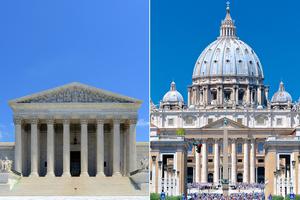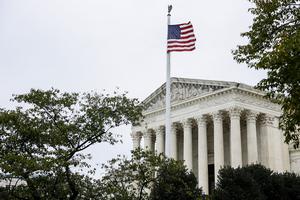‘Espinoza v. Montana’ Is a Victory for Religious Freedom
COMMENTARY: Espinoza is about more than righting the ugly past of anti-Catholicism. It’s about our present and future.

Tuesday’s Supreme Court decision in Espinoza v. Montana Department of Revenue vindicates the free exercise of religion — all religions — but has special meaning for America’s Catholics.
At long last, the Supreme Court erased the vestiges of century-old anti-Catholic bigotry in the United States. The 5-4 decision made clear that the U.S. Constitution required Montana’s modest tuition-assistance program to be available for use at all private schools, including religious ones. Writing for the majority, Chief Justice John Roberts said that excluding a school from a private-school funding program because of its religious character was simply unconstitutional: “A State need not subsidize private education. But once a State decides to do so, it cannot disqualify some private schools solely because they are religious.”
In 2015, the Montana Legislature enacted a tax-credit scholarship program. It offered a dollar-for-dollar tax credit of up to $150 for donations to private organizations funding tuition scholarships for students attending private schools. In administrative rules for the program, the state’s revenue department excluded religiously-affiliated schools from receiving the tuition assistance. It pointed to a provision in Montana’s constitution — a state “Blaine Amendment” — prohibiting public money for any “sectarian” purpose. Three mothers whose children attend a Christian school in Montana filed suit, arguing that their free-exercise rights under the U.S. Constitution’s First Amendment were violated. The state Supreme Court disregarded their plea and, in a surprising move, invalidated the entire program.
Montana’s ban on public aid to “sectarian” schools and institutions goes back to a time of intense anti-Catholicism in the 19th century. In his concurring opinion, Justice Samuel Alito wrote that the bigoted history of “No-aid” provisions like Montana’s “deserves a brief retelling.” “A wave of immigration in the mid-19th century, spurred in part by potato blights in Ireland and Germany, significantly increased this country’s Catholic population,” recounted Alito. Non-Catholics feared the growing number and political influence of Catholic immigrants. Protestant nativists considered these new arrivals “not as citizens of the United States, but as ‘soldiers of the Church of Rome, who ‘would attempt to subvert representative government.’”
Catholic education became a special target of anti-Catholic animus. This spurred efforts to prohibit government funds from benefitting Catholic — “sectarian” — schools at the state level. These state amendments copied House Speaker James Blaine’s unsuccessful attempt to effectively rewrite the First Amendment to bar any aid to Catholic and other “sectarian” schools. “No-aid” language was in Montana’s 1884 territorial constitution and its 1889 state constitution. And Montana was not alone. More than 35 states have some form of Blaine Amendment.
It should come as no surprise that bigotry begets further bigotry. Initially instituted to handicap Catholic schools, state Blaine Amendments morphed into bans on state funding of all religious schools. That is, until Tuesday.
Today, many parents choose to send their children to religious schools — “a choice,” the majority noted, “protected by the Constitution.” No-aid provisions penalize this decision “by cutting families off from otherwise available benefits if they choose a religious private school rather than a secular one, and for no other reason.”
I filed an amicus brief with the Supreme Court on behalf of Montana parents whose children’s educational needs were met at Catholic schools after their local public schools had failed them. Many of them are lower-income families. Access to additional financial assistance will help families like them in Montana and other states to send their kids to schools of their choice. Laser-focused on the practical significance of restoring the Montana private-school scholarship program, Justice Alito wrote: “The program helped parents of modest means do what more affluent parents can do: send their children to a school of their choice.”
The decision couldn’t come at a better time. Despite their historic and current contributions to the well-being of America’s children, Catholic schools across the country are struggling to keep their doors open. Espinoza’s order to dismantle Montana’s Blaine Amendment allows states to respond to the danger of Catholic school closures. Today, nearly 1.8 million students attend Catholic schools, many in the inner cities or rural areas where public schools are failing. Racially and socioeconomically diverse, these schools disproportionately benefit low-income and middle-class children. Minority students make up approximately 20% of the Catholic school population. That is important not because these Catholic schools strive to fill racial quotas, but because these schools strive to live out their call to be places “of inculturation, of apprenticeship in a lively dialogue between young people of different religions and social backgrounds.”
In terms of academics, studies show that Catholic schools go a long way toward eliminating the achievement gap for low-income and minority children. They rank much higher in results — a 99% graduation rate, with 86% of their graduates going on to college — than their public school counterparts.
Catholics can take some comfort that, as the high court wraps up its 2019-2020 term, it wiped away a remnant of anti-Catholicism. But Espinoza is about more than righting the ugly past. It’s about our present and future. Tuesday’s ruling is a monumental victory for religious freedom for all Americans as well for our nation’s kids and Catholic schools.
Andrea Picciotti-Bayer is a legal analyst for the Judicial Education Project.
- Keywords:
- andrea picciotti-bayer
- anti-catholicism
- blaine amendments
- espinoza v. montana department of revenue
- school choice

















